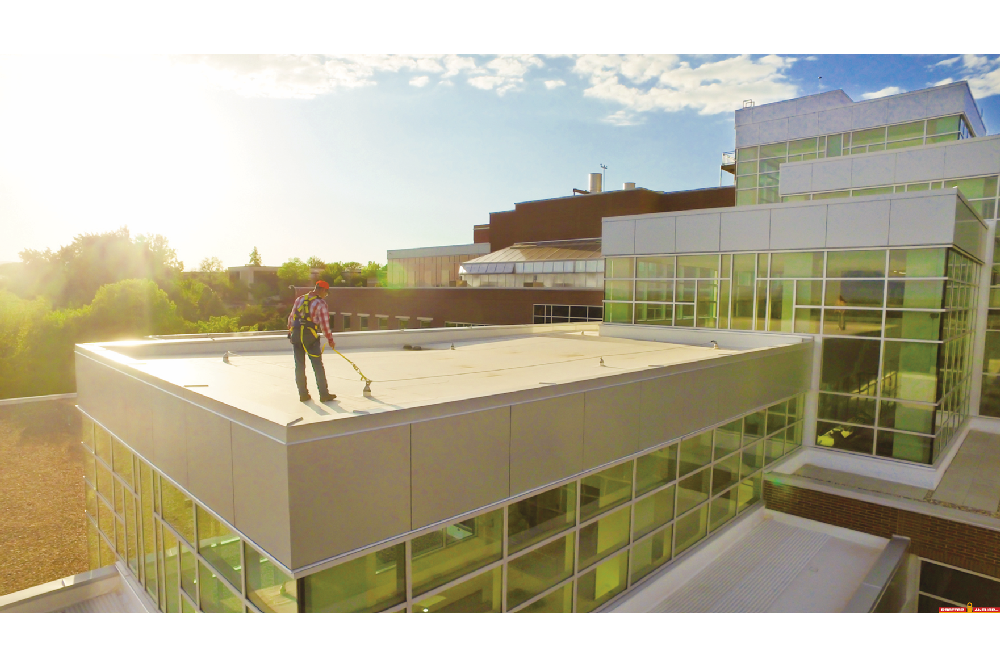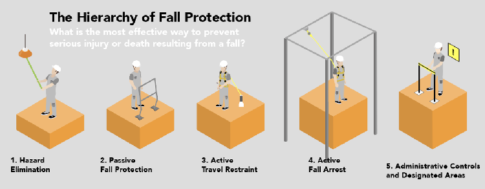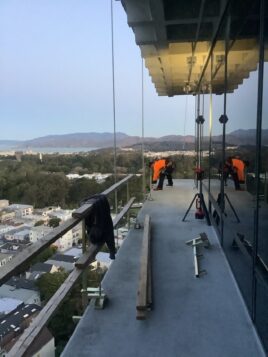
By Philip Jacklin
Falls continue to be a leading cause of death and injury on construction sites. Per Occupational Safety and Health Administration 1926.501, employers must protect construction workers in an environment with the potential to fall 6 feet or more to the next lower level. (Note that general industry companies must adhere to OSHA 1910 and must be protected at 4 feet or more.) On a typical jobsite, the next lower level could be an elevator shaft, several floors of unfinished framing, steel beams, rebar, heavy machinery, the hard earth below or even an excavation pit underneath that.
The following will help superintendents identify and determine the feasibility of various solutions for fall hazards.
The hierarchy of fall protection controls
The hierarchy of fall protection controls offers a systematic approach to identifying solutions that can keep your crew as safe as possible. Applying this to the decision-making process of evaluating solutions puts your workers’ safety top-of-mind, and then progressively places the worker closer to the hazard but with further personal protective measures. The hierarchy proceeds as follows:
- Hazard elimination
- Passive fall protection
- Active travel restraint
- Active fall protection
- Administrative controls
 Let’s discuss what it looks like to properly apply the hierarchy of fall protection controls when attempting to mitigate fall hazards on an active jobsite.
Let’s discuss what it looks like to properly apply the hierarchy of fall protection controls when attempting to mitigate fall hazards on an active jobsite.
Hazard elimination. Eliminating a fall hazard is easier said than done in many construction environments. However, when you evaluate a hazard by trying to remove the hazard altogether, before simply focusing on protecting the worker as-is, you’re able to make the work area safer and eliminate the risk instead of simply reducing the risk or severity of injury.
For example, as a superintendent, you could discuss with building architects and design engineers incorporating parapet walls at least as tall as OSHA-compliant guardrail specifications (+/- 42 inches tall) that could remove rooftop fall hazards during the construction and future building maintenance. Or you could prepare conduit on the ground level before going up at heights for final installation.
Passive fall protection. In many facilities, and especially on active construction sites, it’s is often infeasible to eliminate fall hazards since the nature of constructing buildings is dangerous work. However, passive fall protection methods are quite effective at protecting workers from falls and require minimal user input. Guardrail is a textbook example of a passive fall protection system. As long as it exists in an environment, workers are made aware of the fall hazard the guardrail is protecting against, and it acts as a physical barricade in case of a slip, trip or fall that occurs near the guardrail.
Guardrail is simple to construct, and OSHA helps detail specifications for what classifies as compliant guardrail. A recommended best practice that is gaining popularity is to construct a temporary guardrail as the building’s frame is being constructed. Trade partners, inspectors, vendors and anyone who will have to navigate unfinished floors could benefit from being protected by guardrail constructed at the start of a project. If it’s possible, the best practice would be to install permanent guardrail as the project continues, if the fall hazard will remain once construction is complete. That practice can be extremely beneficial in certain areas, like mezzanines or rooftops.
OSHA, 1926.502 permits guardrail to be constructed if there is a top rail at +/- 42 inches tall (42-45 inches only in California), at least one midrail and toeboards. The top rail must be able to withstand 200 pounds of downward force and the midrail is required to withstand 150 pounds. Toeboards are also required if there is a chance of material falling onto workers below. Toeboards must be at least 3.5 inches tall and can sit no more than 0.25 inches off the ground. If constructing guardrail is not feasible, renting or purchasing prefabricated OSHA-compliant guardrail is always a possibility.
Active travel restraint. Travel restraint is an example of fall prevention equipment as opposed to fall protection equipment. The latter protects workers from the full forces and consequences of a fall, while the former attempts to prevent the fall from occurring altogether.
Travel restraint systems require an anchor point approved by the site’s competent person, a properly donned harness and an appropriate length fall restraint lanyard connected to the user. The connection device must be or can be adjusted to a length less than a worker can walk to reach their leading edge. Also, note the increase in user input required to make a travel restraint system effective compared to a passive system like guardrail. Suppose a worker neglects to use an appropriate length connection device. In that case, the entire system would be rendered useless, and the worker would be subject to a fall without proper equipment to mitigate the fall hazard or consequences of the fall.
Travel restraint systems can prove difficult to establish in temporary settings, but that should not discourage one from considering them. When performed correctly, these systems allow workers to move around a work zone with their risk of falling virtually eliminated as long as they are connected into the fall prevention system.
Active fall protection. Active fall protection is the hierarchy level that most people think of first when trying to mitigate fall hazards. There is nothing inherently wrong with fall protection systems, but they are a reactionary method to mitigate a hazard. The former levels in the hierarchy aim to remove hazards, not just mitigate how they affect the worker. A common fall protection system consists of an anchorage, body harness and a shock-absorbing lanyard or self-retracting lifeline. When determining which connection device to supply to the worker, refer to the product’s label to help determine the minimum required fall clearance for the device and ensure that clearance exists where the worker will be performing their task(s).
This is where things can get exciting. If the building being constructed is a facility that will have your team regularly working at heights, like an aircraft or fleet maintenance facility, the fall protection system(s) that will protect future workers in the building could potentially be used to protect the people also involved in the construction of the building. With discussion and coordination between the building’s future occupant, the building design team and your team, fall protection systems could be specified in the planning phase of design to incorporate fall protection from the very beginning of a project. Examples of these systems could be overhead truss systems, rigid rail trolley systems or horizontal lifelines.
Fall protection systems also require a fall rescue plan in case of a fall. In addition to calling emergency personnel, OSHA requires employers to have the ability to self-rescue a fall victim until first responders arrive, if necessary to assist in a rescue. 911 should always be called in the event of a fall so the victim can receive medical attention, but emergency responders cannot be the only method of rescue offered to workers. Again, coordination with the building design team can help incorporate additional anchor points to be installed during construction that can be utilized for the personal fall arrest system and/or the rescue equipment. There is nothing to be said against these anchor points remaining after construction is complete to benefit future workers, as well. However, it is common that most fall hazards experienced during the building’s construction will no longer exist once it’s complete.
Administrative controls. The last level of the hierarchy is a scary (and dangerous) place to be. It is when all other levels of the hierarchy are determined infeasible, and no fall protection methods can yet be installed. For clarification, OSHA only accepts infeasibility if it is determined that it poses an even greater hazard to try and install fall protection systems at this point in construction. This can be common for framers and erectors who are building the very infrastructure that future anchorages will be installed.
For these scenarios, OSHA mandates these areas be designated as controlled access zones and must possess a safety monitor system and document the limited amount of necessary people that will be allowed into controlled access zones. Ideally, these areas would only exist while initial fall protection systems are being constructed, immediately once the required infrastructure is completed.
Administrative control solutions should be considered a last resort regarding fall protection, as they do not remove the worker from the hazard, do not help to prevent a fall, nor do they mitigate the effects of a fall if it occurs. Some examples of administrative controls are additional signage to warn workers of upcoming hazards or utilizing a safety monitor system. A safety monitor is someone who exclusively supervises the work being performed at heights and verbally communicates to workers as their risk of injury increases while working. These solutions should be used strictly as required to hopefully install fall protection for immediate use. Often, administrative controls are used in conjunction with other systems as part of a comprehensive fall protection plan.
Most organizations and safety teams aim to keep their workers as safe as possible, and the hierarchy of fall protection controls is a helpful resource to make sure all options are considered. While feasibility might be influenced by factors like available time and budget, the hierarchy helps consider the long-term benefits of always trying to remove the hazard before deploying mitigation methods. Eliminating the hazard is always ideal, but hardly ever the easiest task to accomplish. However, fall hazards are too common and dangerous to continue operating without always applying the hierarchy.
Philip Jacklin is continuing education program manager for Diversified Fall Protection.
Images courtesy of Diversified Fall Protection



 Join our thriving community of 70,000+ superintendents and trade professionals on LinkedIn!
Join our thriving community of 70,000+ superintendents and trade professionals on LinkedIn! Search our job board for your next opportunity, or post an opening within your company.
Search our job board for your next opportunity, or post an opening within your company. Subscribe to our monthly
Construction Superintendent eNewsletter and stay current.
Subscribe to our monthly
Construction Superintendent eNewsletter and stay current.